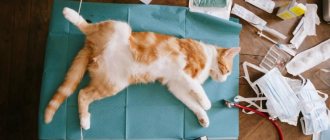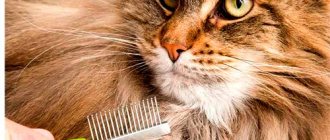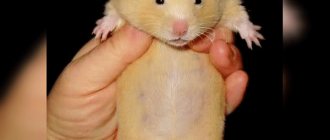(Be the first to vote!)
5589564
09/13/2021 owner reviews
When your cat reaches sexual maturity, usually between 5 and 9 months of age, she may become pregnant and give birth to kittens. If she becomes pregnant, she will carry her litter for about nine weeks until she gives birth. You will need to care for your cat during her pregnancy to ensure the safety of both her and her kittens.
- About the first pregnancy in cats and its signs
- How many days does a cat carry kittens?
- About the number of kittens
- How many months does a cat carry kittens?
- Birth of kittens
Signs of pregnancy in a cat
Only a veterinarian or an experienced breeder can determine pregnancy in the earliest stages. After mating, pregnancy can occur within two to three weeks. Then obvious signs will appear.
At first, the furry pet’s body receives a large dose of hormones, so the nipples swell and turn pink. This happens already 2 weeks after mating. After three to four weeks, a radical restructuring of the body occurs. The animal's activity decreases and nausea may even be present.
After just 7 days, the pet sleeps and eats a lot. Now the animal needs additional nutrients to form embryos. It makes sense to give special vitamins for pregnant cats, which the veterinarian will recommend.
The taste preferences of the expectant mother change, and you may notice mood swings. After 6 weeks, a large belly becomes noticeable, the animal’s movements slow down, and its gait may change.
Estrus during gestation
There are cases of estrus occurring during pregnancy. This occurs in one in ten cats. Most often this happens at 3-6 weeks. If at this time there was mating with a male, then secondary conception occurs. The newly fertilized egg is implanted in the uterus. Embryos also develop from it. At birth, these offspring turn out to be premature compared to those already formed. In most cases it dies. Kittens of the second conception sometimes remain in the uterus and may be born a week after the first.
How long does pregnancy last in cats?
Many breeders are concerned with the question, how many months does a cat’s pregnancy last in general? It lasts only up to 9 weeks – that’s about 65 days. There may be differences in the gestation period due to the characteristics of the breed or a particular individual. Thus, long-haired cat breeds bear kittens for about 10 weeks, while short-haired cats have a gestation period of about 9 weeks. The duration of pregnancy in outbred cats will depend on the standard of living and quality of nutrition.
A cat can bear kittens up to 3 times a year, but this is a lot of stress for the body. Such frequent births simply wear out the body, so it is not recommended to breed a cat more than once a year.
The birth itself begins with contractions, the whole process takes less than a day, usually 3-4 hours. After contractions and pushing, the fetus will appear in the bladder. The animal gnaws the umbilical cord and may eat the afterbirth. After this, the newborn kitten begins to eat, and the mother continues the birth process.
Childbirth is coming soon: signs and course
It is extremely important to know what precedes an early birth. This information will allow you to better understand the expectant mother and have time to prepare for the birth of babies. She may need first aid during this difficult process.
Signs
A harbinger of labor in a cat is considered to be an extremely calm state a couple of days before the onset. There is also a sharp decrease in appetite and a search for a secluded place. As a rule, it is difficult for the expectant mother to walk; most of the time she prefers to lie down. Perhaps he will fawn over the owner and follow on his heels, hinting at your help. The most striking signs can be seen 3–5 days before lambing.
You can reduce your pet's anxiety by creating a cozy nest for the birth of babies during pregnancy. Usually they use a large box or a ready-made house. It is important to cover it with a clean cloth and place it where there are no people. A cat always looks for a distant place to give birth so that no one will disturb her.
Animals during pregnancy may have different opinions on this matter - some choose a closet for lambing or hide under the bed. Ideally, you need to give the expectant mother a room where she will feel comfortable and safe. The constructed house should be prepared several weeks in advance so that the tailed animal has time to get used to it.
A cat needs a secluded area to give birth to kittens.
Course of labor
Having noticed the precursors of childbirth, it is recommended to examine the animal. The cat begins to have mucous discharge from the genital tract, which will facilitate the process. She will begin to actively lick the area under the tail - you will definitely not miss the beginning of birth. It is worth preparing for it in advance to help your pet survive the appearance of offspring. What you may need:
- surgical gloves (several pairs);
- clean scissors;
- dry cloth;
- small syringe;
- antiseptic (iodine, brilliant green, etc.).
It will be better if a specialist monitors the birth process. However, you can cope on your own, the most important thing is not to panic. Even during pregnancy, find a doctor who can advise you over the phone if necessary.
The first signs of labor are contractions. They can last up to 12 hours and are accompanied by bleeding. The expectant mother behaves restlessly: she rushes around the house, screams, and tries to stay closer to the person. You can gently massage the abdomen and speak in a gentle voice.
Kittens pass through the birth bladder head first. Next, the female must bite through the amniotic sac, gnaw the umbilical cord and lick the crumbs. Sometimes the owner has to help: cut the umbilical cord himself with clean scissors, clear the mouth and nose of mucus. It doesn't hurt to first make sure that the cat doesn't mind your help.
A cat can give birth on its own, but with the help of the owner and the veterinarian, the process will definitely be safe for her and the kittens.
The duration of labor usually does not exceed 7–8 hours (from the moment the abdominal cramps begin until the kitten is born), but the process sometimes drags on for up to a day. The fewer kids, the faster everything goes. If the expectant mother has no pathologies and the pregnancy is proceeding normally, everything will be easy. Still, be careful and, if necessary, immediately seek help from a veterinarian.
After birth, the mother quickly returns to normal, although spotting can last up to three weeks. In the absence of alarming symptoms (nausea and vomiting, weakness, fever), this is not a pathology.
In conclusion, let us recall that gestation in cats lasts on average 2 months (57–60 days). Some breeds have different gestation periods. Even during mating, it is worth observing the behavior of your pet in order to determine the date of conception as accurately as possible. It will not be superfluous to prepare in advance for the birth of furry babies by building the correct diet for the cat using the species-typical SUPERPET nutrition.
Diagnosis of pregnancy
To prepare for an important event, you need to understand your pet's gestation period. The period is determined by the external signs that the cat’s body shows. On days 16-18, the nipples become a bright coral color. Also, due to decreased activity and frequent feeding, the cat’s weight increases. But you need to make sure that this is really pregnancy, and not a consequence of the development of parasites in the body.
Therefore, you should definitely undergo a veterinary examination:
- Palpation. An experienced veterinarian can feel the embryos as early as the third week and determine the cat’s gestational age, and closer to the sixth week he can tell how many kittens there will be.
- X-ray. This method is used extremely rarely, as it can harm the embryos, but sometimes you can’t do without it.
- Ultrasound. The simplest method, which is used everywhere and helps to track whether there are any developmental disorders in kittens.
Birth of kittens
Around day 58 of pregnancy, begin checking your cat's temperature with a rectal thermometer twice daily. The normal temperature of cats ranges from 38 to 39 degrees Celsius. Once the temperature drops by about two degrees, labor usually begins within 24 hours. Your cat may also stop eating 24 hours before giving birth.
Prepare for the birth of kittens by putting together a cardboard box lined with blankets or newspapers for your cat to give birth in, and setting up a nest for her and the kittens. Place the box in a quiet area of the house where the cat has easy access. When she's ready, let her go to the crate and watch her labor, which usually lasts about six hours. Do not disturb or move her during this time.
How to properly care for a pregnant cat?
First, you need to make sure your cat is getting enough nutrition. As mentioned above, she may eat more than usual during this time. When half the term has passed, the owner, on the contrary, will need to introduce some dietary restrictions: the amount of food should be reduced in portions, and the intervals between feedings should be reduced.
If feeding the cat consisted of natural food, then you need to add a large amount of cottage cheese and kefir - the animal’s body needs calcium. You can also choose specialized food for pregnant cats.
The veterinarian will advise on the need for vitamin or mineral supplements after examining the pet. It is important for the animal to remain in good physical shape, so do not deny it moderately active games.
Care must be taken to ensure that the cat does not contract any infection. Therefore, it is important to protect her from communicating with other cats, especially those that constantly live outside. The cat may become infected with worms and become more aggressive, which can lead to fights and injuries.
The pet needs to be examined daily - any deviation from the norm should alert the owner. The reason to visit a veterinary clinic may be the cat’s weakness, refusal to eat long before the due date, or excessive vaginal discharge.
Puberty of cats
The onset of puberty depends on belonging to a particular breed. For example, Siamese and Balinese ripen earlier. Representatives of large-bodied breeds, Maine Coon and Scottish Straight, are distinguished by late maturation. Physiological maturity also depends on the time of birth of the kitten. Those born in summer become sexually mature faster than in winter.
During the maturation period, the so-called “cat” songs begin. These are gentle meows and uterine sounds that communicate intentions. Such “concerts” can last a long time . The cats become overly affectionate and loving. They constantly clean themselves up and mark their territory. They often rub against the owner's legs and the legs of tables and chairs. A caring owner understands that it is time for the pet to look for a partner. But when your cat is in heat for the first time, you should not pair her with a male cat. Puberty does not yet indicate the complete physical development of an animal.
The body's readiness to bear healthy kittens occurs at fourteen months.
It happens that a cat demands a cat, but due to her age she is not yet ready for pregnancy. In this case, on the advice of a veterinarian, you can reduce libido with medications. This will calm your pet, and she will stop asking to go outside. The owner will protect himself from unplanned mating and the associated unwanted pregnancy of the cat. During courtship, cats receive multiple wounds in fights with rivals. After running away from home, pets can return infected with various diseases, including parasites. Therefore, during the period of heat, owners should carefully monitor their pets.
How to prepare a place for offspring?
During childbirth, the animal feels calmer in a quiet, secluded place, so you need to prepare a bed or box in advance. The peace of the last two weeks depends on the behavior of all household members. Young children especially should not fuss while waiting for a kitten, this will make the cat nervous.
Over time, you need to accustom the animal to a new resting place. But it also happens that for some reason the cat does not like the bed, then you just need to track where the animal tries to hide during childbirth.
Order pet products in Krasnoyarsk from the Pharmacia online pharmacy. Ordering products through online search is available with a discount of up to 10%.
About the number of kittens
There can be from 1 to 6 of them in one litter. It all depends on the characteristics of the cat’s body, its strength, and genetics. These animals have a two-horned uterus. Fertilized eggs move through the horns and attach to the walls. The birth of more than 6 kittens is rare. Typically, a pet's very first litter contains one to three kittens. And aging cats are not very fertile. Having reached old age, they stop giving birth. Although there are known cases of offspring appearing in cats up to 12 years of age. Of course, health will no longer be different. By the way, in old age cats can experience maternal feelings towards other kittens. Most likely, this is the grandmother's instinct.
Very often in one litter all babies can be of different colors. This is due to the mother’s individual preferences, her temperament, and tastes. For example, if a lady loves black cats, then her offspring will almost always be the same color. And when a cat mates with different males for several hours, her children will be multi-colored. After all, fathers are different!
What age is most favorable for offspring?
A pet can become pregnant for the first time at the age of 6 months, she has her first estrus, and is ready to reproduce. But veterinarians advise not to allow mating at this time, because she is not psychologically ready to become a mother; in fact, she is still a teenager. Early birth can bring health complications; kittens are usually weak, painful, and sometimes incapable of life. Experienced cat breeders recommend waiting for the second or even third heat.
Preparing for lambing
The owner can learn that the moment of lambing is approaching by the behavior of the pet: the cat intensively licks itself and begins to look for a cozy, suitable place for giving birth. For this purpose, you should prepare a clean, spacious box in advance and make a hole for a manhole on one of the walls. Clean towels or sheets are placed in the box and changed as needed. The box is covered with a lid on top to ensure optimal temperature conditions for future offspring. It is recommended to locate this structure in a quiet, dry, dark place, and keep it perfectly clean.
It also does not hurt the owners to stock up on the minimum necessary list of medications and auxiliary materials, namely:
- disinfectant (alcohol or hydrogen peroxide will do);
- clean diapers;
- scissors;
- special sterile wipes;
- brilliant green (needed when processing the umbilical cord);
- cotton threads for tying the umbilical cord;
- veterinarian contacts.
An additional list of medications can also be clarified by visiting a veterinary clinic in advance.











